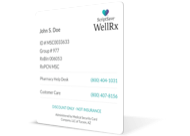Copyright 2024
Medical Security Card Company, LLC
All Rights Reserved
WellRx will never sell your personal information. Period. By signing up I agree to WellRx's terms of use and privacy policy.
By Dr. Nicole Craven, MD
June 22, 2021
Vitamin D—the “sunshine” vitamin—is recognized as one of the most beneficial vitamins for our cellular function. Did you know the UK provided all vulnerable citizens a bottle of Vitamin D this winter? That is pretty good proof of its importance.
Many doctors and nutritionists argue that vitamin D is the single MOST important vitamin to supplement. Here are just some of the benefits the sunshine vitamin offers:
Most people are at risk for Vitamin D insufficiency, especially during the winter months. Here is a list of people who have increased risk:
Vitamin D status can be assessed through blood 25-hydroxy-Vitamin D levels, 25(OH)D. This lab should be done as part of routine lab work no matter the time of year. Of course, the value is likely to be significantly lower over the winter. But many people remain deficient in the summer months.
Most labs report “normal” levels of 25(OH)D as a rather wide reference range of 30 ng/ml to 100 ng/ml (or 50 nmol/l to 250 nmol/l). The United States measures Vitamin D in nanograms per milliliter (ng/ml) while most other countries use nanomoles per liter (nmol/l). To convert from ng/ml to nmol/l, use this formula: 1 ng/ml = 2.5 nmol/l.
Most medical providers would agree that Vitamin D below 30 ng/ml is deficient. The level considered sufficient or even optimal varies widely, and likely depends on many factors, including age, gender, race/ethnicity, weight, and underlying health status.
The National Health and Nutrition Examination Survey (NHANES) defines Vitamin D deficiency and insufficiency as follows:
An NHANES study between 2001–2004 found that 9% of all children aged 1-21 years had Vitamin D deficiency, and 61% had Vitamin D insufficiency. That’s nearly 3 out of 4 U.S. children (58.4 million children) with inadequate Vitamin D levels, with many more children likely having suboptimal Vitamin D levels.
Most functional and holistic medicine doctors helping to optimize vitamin levels for best cellular function aim for Vitamin D levels in the range of 60–90 ng/ml.
Ultraviolet-B (UVB) radiation from the sun at wavelengths of 290–315 nm is the main non-dietary source of Vitamin D. With UVB exposure, the skin converts 7-dehydrocholesterol to pre-vitamin D3, which then gets converted to 25-hydroxyvitamin D in the liver and subsequently to 1,25-dihydroxyvitamin D in the kidneys.
Most people will not get sufficient Vitamin D levels from sunshine alone, for many reasons:
As much as food can be medicinal, not many foods provide an adequate amount of Vitamin D. Foods highest in Vitamin D include:
When supplementing Vitamin D, use Vitamin D3 (cholecalciferol) rather than Vitamin D2 (ergocalciferol). Vitamin D3 is the form made by your skin when exposed to sunlight and has been shown clinically to be more effective than Vitamin D2.
The Institute of Medicine notes the Tolerable Upper Intake Level (UL) of Vitamin D to be 4000 IU for teenagers and adults, with lower levels noted for infants and children. For the average adult, a daily intake of 4,000 IU of Vitamin D corresponds to a mean 25(OH)D level of about 50 ng/ml (125 nmol/L).
As always, check with your physician before starting any dietary supplements. While Vitamin D toxicity is extremely rare, increased risk for toxicity may exist with obesity, chronic kidney disease, and certain genetic disorders. Administration of Vitamin D3 20,000 IU daily for at least one year in healthy adult males did not reach toxic levels25(OH) levels >100 ng/ml.
The Endocrine Society has evidence-based recommendations in their Clinical Practice Guidelines for the Evaluation, Treatment, and Prevention of Vitamin D Deficiency. They state the Tolerable Upper Limits of dosing when there is a known deficiency to be:
The Endocrine Society further notes that “higher levels of 2,000 IU/[day] for children 0–1 year, 4,000 IU/[day] for children 1–18 years, and 10,000 IU/[day] for children and adults 19 years and older may be needed to correct vitamin D deficiency.”
When you do not have access to 25(OH)D testing for you or your child, the following are likely safe dosages by age:
Providing Vitamin D could be one of the most important public health priorities of our time. So, why not take the initiative to improve your health with this rich vitamin? You can get your Cholecalciferol Vitamin D3 at the right dose for you with ScriptSave WellRx.
Should You Be Taking Vitamin D?
Vitamin D2 vs. D3: What Is the Difference, and Which Is Better?
Do You Need Vitamin D? And What’s the Difference Between D2 and D3?
Cholecalciferol Vitamin D3 Dosage
Dr. Nicole Craven, MD, completed her Pediatric Residency at the Medical University of South Carolina in Charleston, and her Integrative Medicine Fellowship in Tucson, AZ with Dr. Andrew Weil. As an integrative medicine doctor, pediatrician, and previous practice owner, Dr. Craven also devotes time to scientific writing, copywriting, marketing for natural health and medicine companies, speaking, and consulting.
References:
https://www.bbc.com/news/health-55108613
https://pubmed.ncbi.nlm.nih.gov/28202713/
https://pubmed.ncbi.nlm.nih.gov/26680471/
https://pubmed.ncbi.nlm.nih.gov/30275418/
https://pubmed.ncbi.nlm.nih.gov/27147283/
https://www.health.harvard.edu/staying-healthy/time-for-more-vitamin-d
https://pubmed.ncbi.nlm.nih.gov/20163416/
https://pubmed.ncbi.nlm.nih.gov/32180081/
https://pubmed.ncbi.nlm.nih.gov/25372709/
https://pubmed.ncbi.nlm.nih.gov/21646368/

For your convenience, use the ScriptSave® WellRx mobile app. Now savings are well in hand, right at the pharmacy counter. Save on your family's prescription medicines.
Learn More
Your choice. Get a ScriptSave WellRx Savings Card. Or Download the free mobile app from the App Store or Google Play Store
Get A Card
ScriptSave WellRx Grocery Guidance leverages leading-edge nutritional data science to help you know which food products on your grocery store shelf are truly good for YOU.
Healthy Foods For YouTags:

November 07, 2024

October 23, 2024

May 07, 2024
You need to log into the site to use this feature
This feature requires registration. Sign up or log in to your free WellRx account to gain access to this and other tools to help make managing your medications and wellness easier.
Benefits Include:
 Store & manage your medication list
Store & manage your medication list
 Medication pricing updates
Medication pricing updates
 Medication information
Medication information
 Pill & refill reminders
Pill & refill reminders
 Medication journal & mood log
Medication journal & mood log
This feature requires registration. Sign up or log in to your free WellRx account to gain access to this and other tools to help make managing your medications and wellness easier.
Benefits Include:
 Store & manage your medication list
Store & manage your medication list
 Medication pricing updates
Medication pricing updates
 Medication information
Medication information
 Pill & refill reminders
Pill & refill reminders
 Medication journal & mood log
Medication journal & mood log
You will be redirected to your program in 5 seconds.
Our Terms and Conditions and Privacy Policy have recently been updated.
By declining you will be logged out of your account